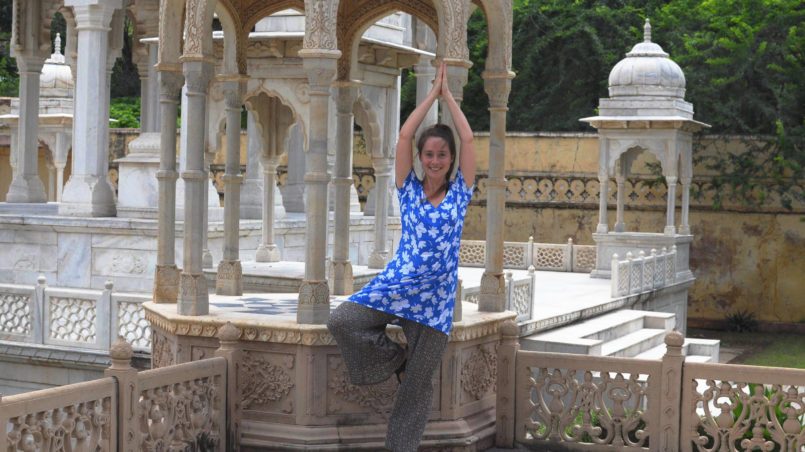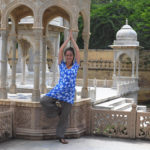My Journey with Scoliosis: Searching for Balance

When I was 16, I was diagnosed with scoliosis. This means, in my case, two slight arches in my spine and a distinct pelvic obliquity, which makes one leg slightly shorter than the other. According to the doctor, the only treatment methods for treating scoliosis were, firstly, wearing a corset and secondly, surgery. For the former, it was already too late for me, because I was already in adolescence and my body had already developed to a great extent. And the latter is a very complex and risky intervention, which is generally only recommended in very bad cases. Both of them seemed very radical and even then, I was sceptical about both:
Either you squeeze yourself into a corset as a child at night and survive the pain and discomfort, or you undergo the risky and radical strains of an operation. I thought to myself that there must be other ways…
So what exactly does scoliosis mean?
If the back of a person affected by scoliosis is viewed from behind, significant lateral deviations of the spine from the straight midline can be detected. The intensity of lateral curvature depends on the severity of scoliosis. A distinction is made between congenital and non-born scoliosis, the latter being considerably more common (approx. 90% of cases) and only developing in one of the growth phases, during childhood and adolescence.
Generally speaking, almost nobody possesses a perfectly straight spine. However, a deformity of the spine is treated orthopaedically from about ten degrees of curvature. The exact origin of scoliosis is unclear and is not scientifically proven. There is usually a higher risk when young people are experiencing rapid and strong growth spurts or longer periods of hormonal growth.
In order to prevent my scoliosis from worsening, the orthopedist advised me to go to ballet lessons to improve my posture. He also prescribed a five-week treatment program in a clinic in which young people with scoliosis are treated according to the Katharina-Schroth method. The latter was a stringent training program and helped me to temporarily improve my scoliosis. I also attended ballet lessons for a few years, more or less motivated. Especially the treatment helped me to improve my posture and gave me guidelines for specific scoliosis exercises.
Unfortunately, I could never achieve a sane level of aspiration during my youth and saw scoliosis exercises as a responsibility. The belief that all people could see my malposition was anchored within me as was the belief that I could never be good in a physical discipline. I subconsciously adapted a negative view of my own body and the stigma of my scoliosis as a “problem” that needed to be fixed.
A few years later, I became acquainted with yoga. This was when I found something that I personally had never been able to experience in ballet: a balance – for my body as well as for my mind.
Over the years, however, I have found that the condition of my scoliosis has not really changed. Sometimes I have even had the feeling that it was getting worse, although I never disregarded it and always tried to find physical balance.
Opinions on the course of scoliosis differ here. Some people, both medical and non-medical, advised me to forget about scoliosis because there is nothing I can do about it anyway and I only make myself unhappy by focusing too much on my “problem”. Others advised me to stay on the ball and work to ensure that “the problem” did not get worse. Here the confusion set in because I somehow believed both parties and therefore did not know which path I should now take.
Last year I stayed in an Indian yoga ashram for a few weeks, where I developed stiff neck muscles as a result of many shoulder-heavy exercises, which greatly restricted my movements. I knew that this was due to the twisting of my spine and that some yoga positions were not suitable for me due to scoliosis. In addition, I had tried many different yoga styles years before and had always tried to practise them as correctly as possible.
In May 2017 I came across the osteopathic clinic “Bone & Body” in India. At the time, I was in the Dharamsala region of northern India for a longer period and decided to spend two months in this clinic building up my back. Since this program was very effective and has given me a new and balanced body feeling, I am currently in Goa, South India, where the clinic is located, for the second time since my time in Dharamsala.
Here I am continuing with my build-up program for a few weeks to achieve a constant stabilisation and improvement of my condition. The program at Bone & Body has shown me that a permanent correction of my malposition is possible. Therefore I will take a closer look at this place in the next part of this series and explain the treatment methods and background.
Sources and further information on scoliosis:
http://www.skoliose.at/en/scoliosis
http://www.schoen-kliniken.com/ptp/medizin/ruecken/verformungen/skoliose
About the Katharina Schroth therapy, which also follows a helpful approach for the correction of scoliosis:
http://www.deutsches-skoliose-netzwerk.de/wp-content/uploads
Translation German-English: Anna Dichen
Credits
| Image | Title | Author | License |
|---|---|---|---|
 |
00-Auf-der-Suche-nach-Balance_Lisa Dau_CC-BY-SA-4.0- | Lisa Dau | CC BY-SA 4.0 |
